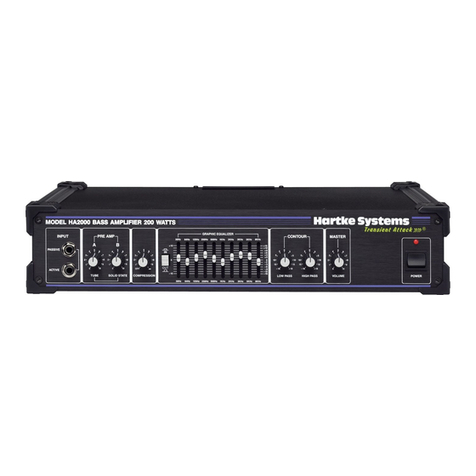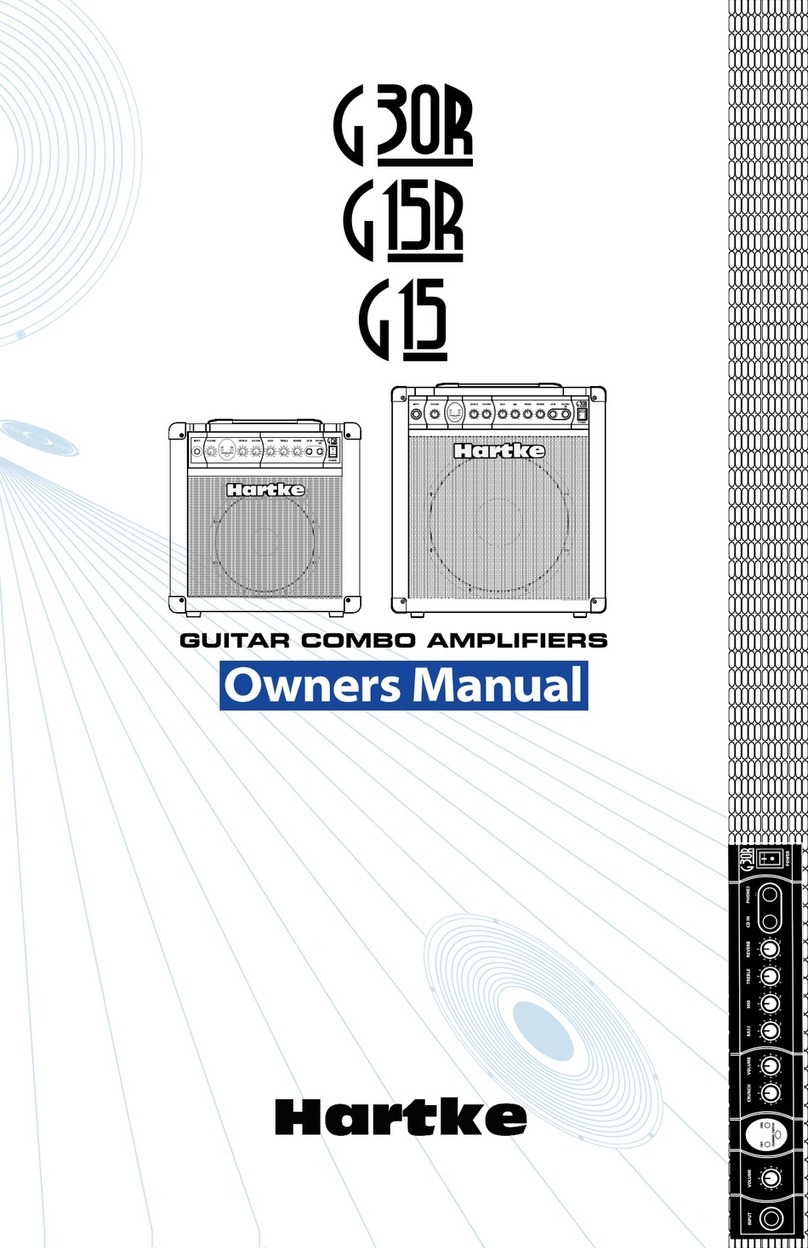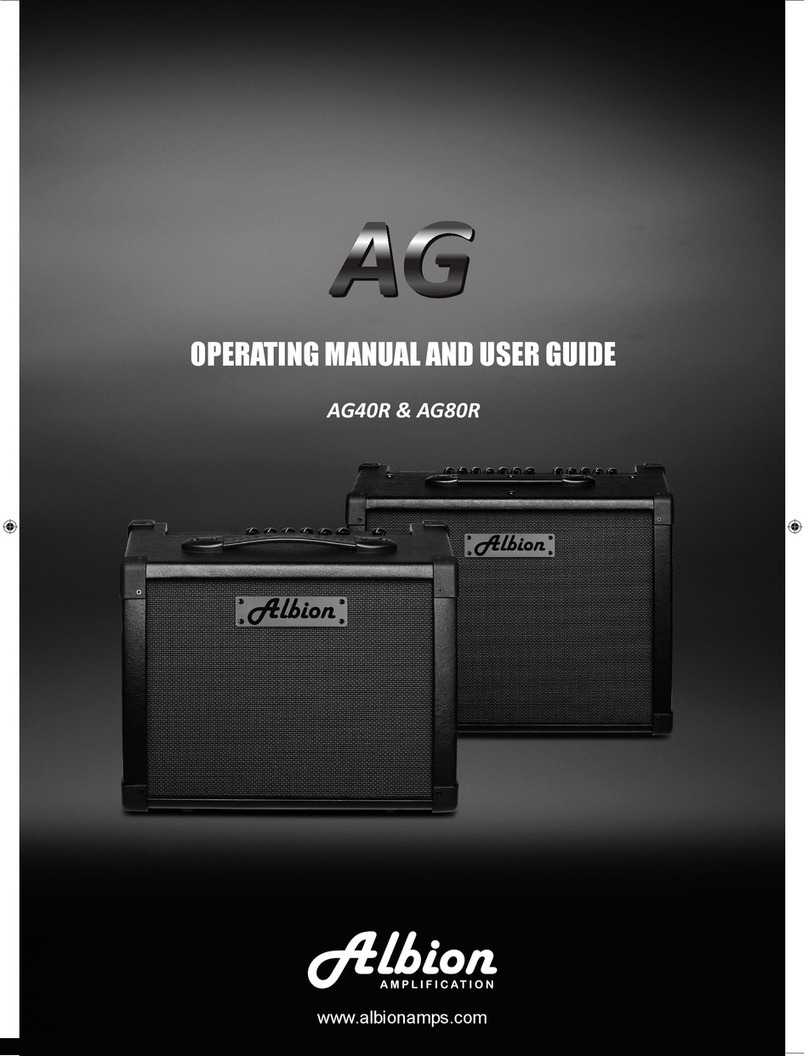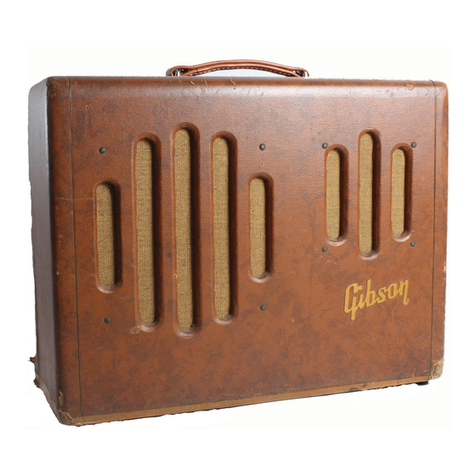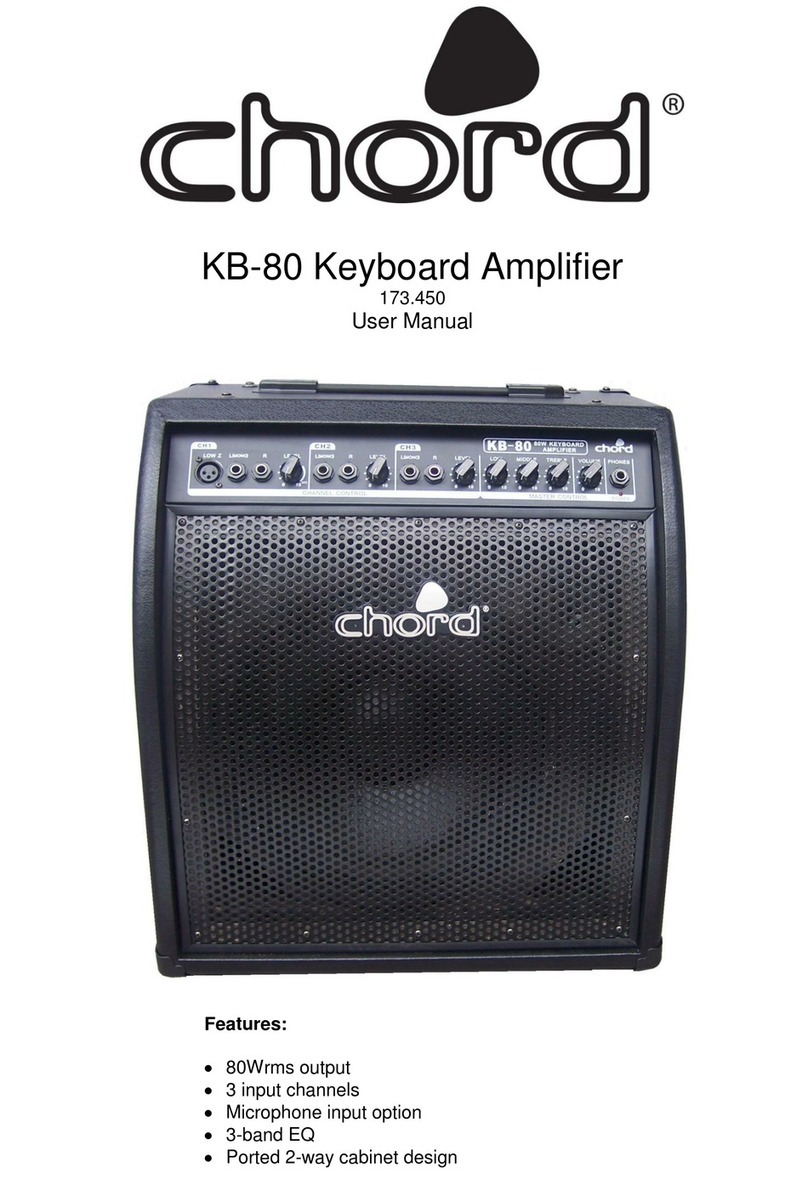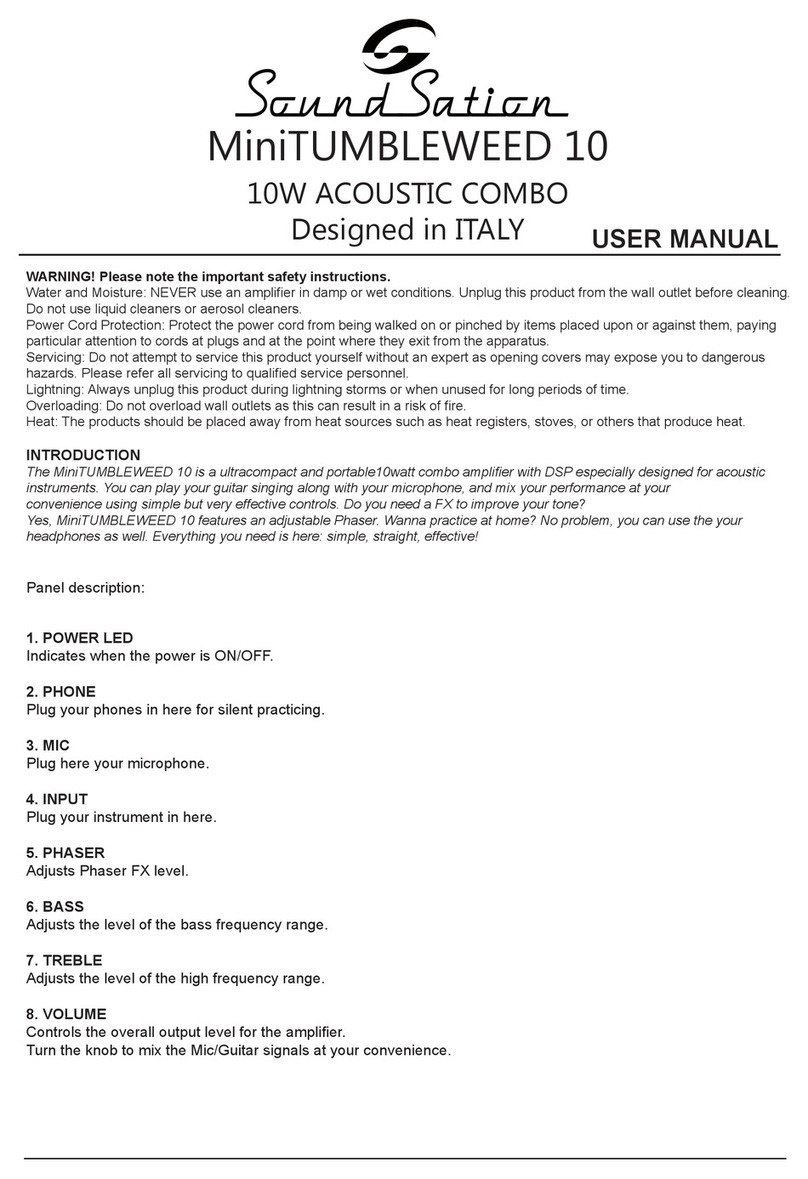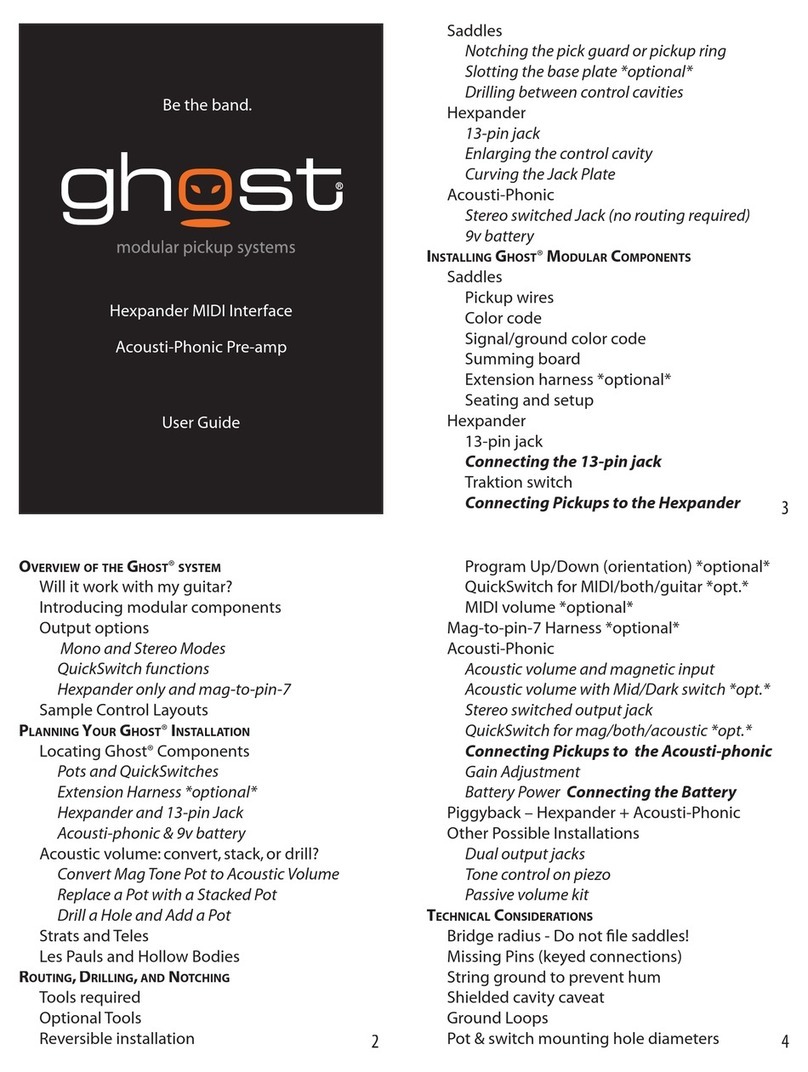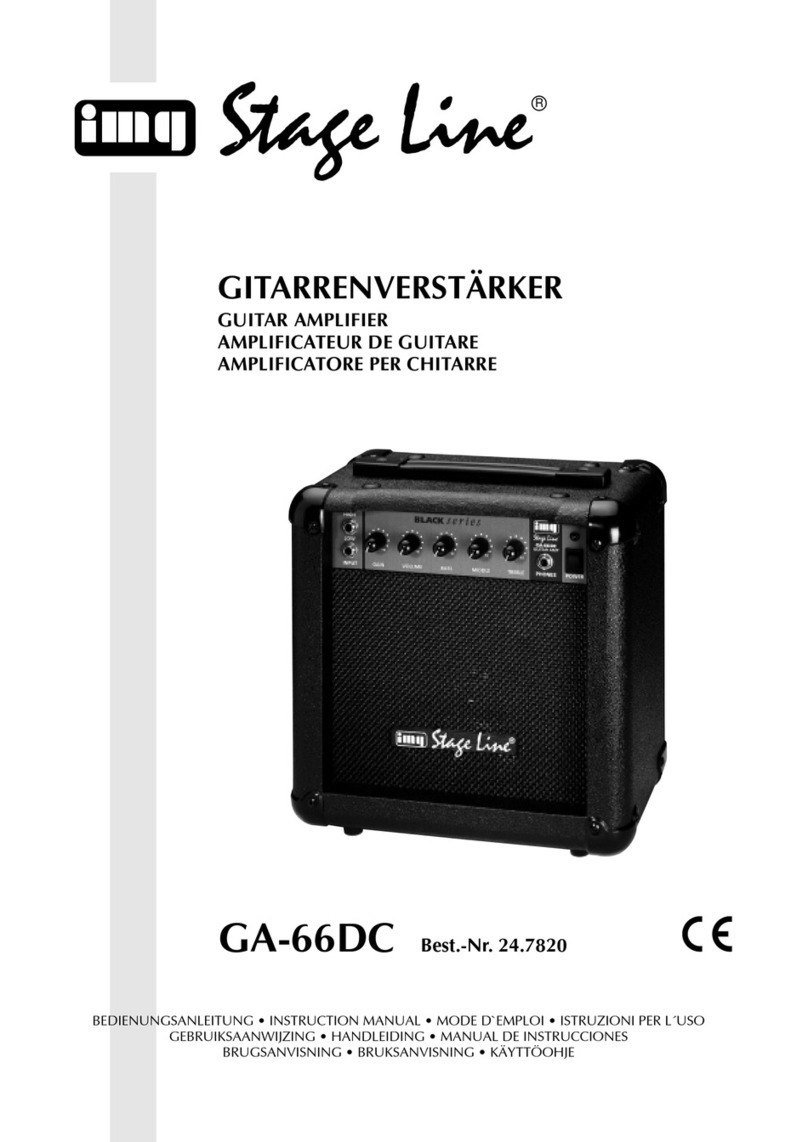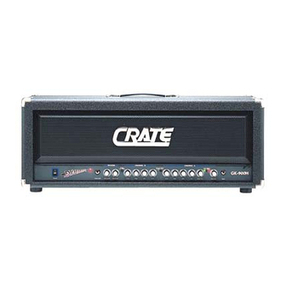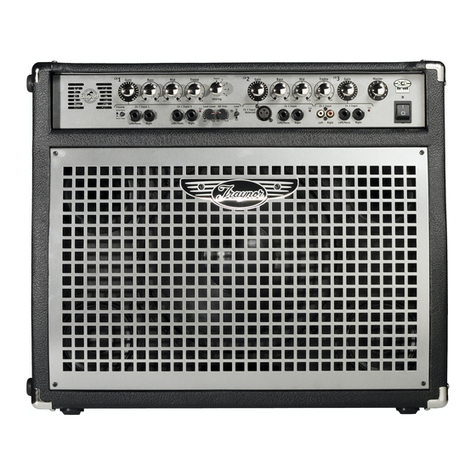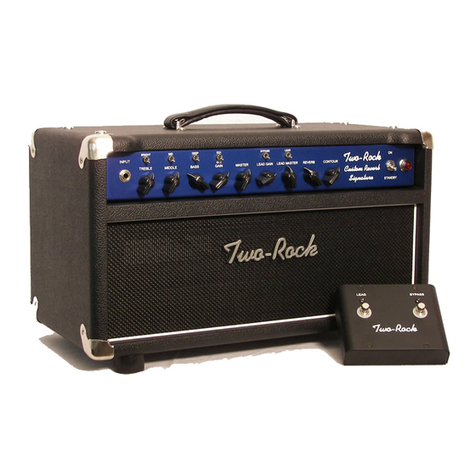Hartke TX600 User manual

Owner's Manual

2
Important Safety Information
WARNING: TO REDUCE THE RISK OF ELECTRIC SHOCK, DO NOT REMOVE COVER (OR BACK)
AS THERE ARE NO USER-SERVICEABLE PARTS INSIDE. REFER SERVICING TO QUALIFIED
SERVICE PERSONNEL.
This lightning flash with arrowhead symbol within an equilateral triangle
is intended to alert the user to the presence of non-insulated “dangerous
voltage” within the product’s enclosure that may be of sufficient magni-
tude to constitute a risk of electric shock.
The exclamation point within an equilateral triangle is intended to alert
the user to the presence of important operating and maintenance in-
structions in the literature accompanying the appliance.
ATTENTION
RISQUE DE CHOC ÉLECTRONIQUE -
NE PAS OUVRIR
FCC Notice
This device complies with part 15 of the FCC Rules. Operation is subject to the following two condi-
tions: (1)this device may not cause harmful interference,and (2)this device must accept any interfer-
ence received, including interference that may cause undesired operation.
Changes or modifications not expressly approved by the party responsible for compliance could void
the user’s authority to operate the equipment.
NOTE: This equipment has been tested and found to comply with the limits for a Class B digital
device, pursuant to Part 15 of the FCC Rules. These limits are designed to provide reasonable pro-
tection against harmful interference in a residential installation. This equipment generates, uses and
can radiate radio frequency energy and, if not installed and used in accordance with the instructions,
may cause harmful interference to radio communications. However, there is no guarantee that inter-
ference will not occur in a particular installation. If this equipment does cause harmful interference
to radio or television reception, which can be determined by turning the equipment off and on, the
user is encouraged to try to correct the interference by one or more of the following measures:
• Reorient or relocate the receiving antenna.
• Increase the separation between the equipment and receiver.
• Connect the equipment into an outlet on a circuit different from that to which the receiver is
connected.
• Consult the dealer or an experienced radio/TV technician for help.
Samson Technologies Corp.
©2016, V1
45 Gilpin Avenue
Hauppauge, New York 11788-8816
Phone: 1-800-3-SAMSON (1-800-372-6766)
Fax: 631-784-2201
www.samsontech.com

TX600 - 600 Watt Bass Amplifier 3
1. Read these instructions.
2. Keep these instructions.
3. Heed all warnings.
4. Follow all instructions.
5. Do not use this apparatus near water.
6. Clean only with dry cloth.
7. Do not block any ventilation openings. Install in accordance with the manufacturer’s instruc-
tions.
8. Do not install near any heat sources such as radiators, heat registers, stoves, or other apparatus
(including amplifiers) that produce heat.
9. Do not defeat the safety purpose of the polarized or grounding type plug. A polarized plug has
two blades with one wider than the other. A grounding type plug has two blades and a third
grounding prong. The wide blade or the third prong are provided for your safety. If the provided
plug does not fit into your outlet, consult an electrician for replacement of the obsolete outlet.
10. Protect the power cord from being walked on or pinched particularly at the plugs, convenience
receptacles, and at the point where they exit from the apparatus.
11. Only use attachments/accessories specified by the manufacturer.
12. Use only with the cart, stand, tripod, bracket, or table specified by the manufacturer, or sold
with the apparatus. When a cart is used, use caution when moving the cart/apparatus combina-
tion to avoid injury from tip-over.
13. Unplug the apparatus during lightening storms or when unused for long periods
of time.
14. Refer all servicing to qualified personnel. Service is required when the ap-
paratus has been damaged in any way, such as power supply cord or plug is
damaged, liquid has been spilled or objects have fallen into the apparatus has been exposed to
rain or moisture, does not operate normally, or has been dropped.
15. This appliance shall not be exposed to dripping or splashing water and that no object filled with
liquid such as vases shall be placed on the apparatus.
16. Caution-to prevent electrical shock, match wide blade plug wide slot fully insert.
17. Please keep a good ventilation environment around the entire unit.
If you want to dispose this product, do not mix it with general household waste. There is a
separate collection system for used electronic products in accordance with legislation that
requires proper treatment, recovery and recycling.
Private household in the 28 member states of the EU, in Switzerland and Norway may
return their used electronic products free of charge to designated collection facilities or to
a retailer (if you purchase a similar new one).
For Countries not mentioned above, please contact your local authorities for a correct method of
disposal.
By doing so you will ensure that your disposed product undergoes the necessary treatment, recovery
and recycling and thus prevent potential negative effects on the environment and human health.
Important Safety Information

4
Congratulations on the purchase of your new Hartke TX600 Bass Amplifier! We know
you don’t like reading owner’s manuals, but we suggest you take some time to go
through these pages to fully understand how we’ve implemented a number of unique
features.
The TX600 is a lightweight, 600-watt Class D bass amplifier that offers the legend-
ary Hartke tube preamp circuitry in a highly portable design. To sculpt your sound,
the TX600 features a class-A, tube preamp, and logically arranged tone controls. The
TX600 offers a classic tone stack three-band EQ, with Hartke’s Shape circuit. To round
out the dynamics, there is a fast and articulate variable Compressor circuit.
With an aluminum chassis with integral handle, the TX600 is rugged yet lightweight,
making it the perfect amplifier for nightly gigs. To connect your amplifier to speaker
cabinets, the TX600 has both 1/4” and Speakon® output jacks. The TX600 also
provides connections for signal routing features, including a direct output and preamp
out/power-amp in. You’ll find the TX600 the ideal choice for every performance
situation—from the studio to the stage.
In these pages, you’ll find descriptions of the many features of the TX600 bass amplifier
as well as instructions for setting up and using the amplifier. You’ll also find a warranty
card enclosed—please don’t forget to follow the instructions so that you can receive
online technical support and so we can send you updated information about these and
other Hartke products in the future. Also, be sure to check out our website (hartke.com)
for complete information about our full product line.
We recommend you keep the following records for reference, as well as a copy of your
sales receipt.
Serial number: _________________________
Date of purchase: _______________________
With proper care and maintenance, your TX600 will operate trouble-free for many years.
Should your TX600 ever require servicing, a Return Authorization (RA) number must be
obtained before shipping your unit to Hartke. Without this number, the unit will not be
accepted. Please call Samson at 1-800-372-6766 for an RA number prior to shipping
your unit. Please retain the original packing materials and, if possible, return the unit in
its original carton. If your TX600 was purchased outside of the United States, contact
your local distributor for warranty details and service information.
Introduction
Features
• 600 watts delivered to a 4≈speaker system
• Lightweight aluminum construction weighing only 7lb
• Classic 12AX7 tube high-voltage preamp circuit provides great tone
• Bass and Treble Shelving, plus Mid Shape EQ Controls, allows you to create a broad
range of tonal colors for your bass instrument
• Two independent inputs to accommodate both passive and active bass guitars
• 1/4” plus Speakon® Output connectors for connecting speaker cabinets
• Variable compressor adds real “punch” to your bass sound, and allows you to smooth out
volume dierences between notes
• Preamp output and power am input that allow you to connect to professional
outboard effects processors
• Electronically balanced direct output for routing signal to professional mixing consoles
• Rugged construction with integral handle makes the TX600 exceedingly road-worthy

TX600 - 600 Watt Bass Amplifier 5
Front Panel Callouts
1. PASSIVE Input jack - If your bass guitar has passive circuitry, connect it here. This
standard, 1/4” unbalanced jack provides a high impedance (100 kΩ) input sensi-
tivity of 20 mV.
2. ACTIVE Input jack - If your bass guitar has active circuitry, connect it here. This stan-
dard, 1/4” unbalanced jack provides a high impedance (100 kΩ) input sensitivity
of 60 mV. Note: Bass guitars that have active circuitry normally require a battery for
the circuitry to be functional.
3. MUTE Switch - When engaged, this orange backlit switch mutes all of the outputs.
4. COMPRESSOR Knob - This knob determines the amount of compression by adjusting
the threshold level. The compressor allows you to control the overall dynamic range
of your performance by reducing sudden peaks, and increasing the sustain of the
instrument. At the fully counterclockwise position, no compression is applied. As
the knob is turned clockwise an increasing amount of compression is applied. When
the compressor is engaged the lights around the COMPRESSOR knob flashes yellow
providing a visual indicator of the status of the compression circuitry.
5. GAIN Knob - This control adjusts the amount of level provided to the tube preamp
stage. The lights around the GAIN knob will flash red when clipping occurs in the
preamp signal path. If you notice that the light is continuously flashing red, turn
the GAIN control down until the indicator no longer lights.
6. BRITE switch - Use this switch to turn on the BRITE circuit, which when engaged,
adds a preset EQ curve to enhance the bass instrument’s high-end response. When
engaged the switch will light orange.
7. BASS (80Hz) Knob - As part of the passive tone stack equalizer, this control is used
to adjust the low frequency response.
8. FREQUENCY Knob - This control knob is used to set the center frequency for the mid-
band EQ. The range is from 200Hz to 800Hz.
9. SHAPE Knob - The SHAPE control knob is used to set the depth of the mid-band EQ.
10. TREBLE (6k) Knob - As part of the passive tone stack equalizer, this control is used
to adjust the high frequency response.
11. MASTER Knob - This is the overall volume control for the amplifier.
12. AUX Input - Use this 1/8” input to connect a line level device like a portable CD or
MP3 player.
13. Headphones jack - Connect headphones to this standard 1/8” jack. When a plug is
inserted into the headphone jack, the speaker output is disconnected, allowing you
to use your TX600 as a practice amplifier.
12 3 45 6 7 8 9 10 11 12 13

6
Rear Panel Callouts
1. PREAMP OUT Jack - This output jack is fed from the preamp, and may be used with an
external power amplifier, to connect to a mixing console, or to an effects processor.
Use a standard 1/4” instrument cable when connecting to external devices.
2. POWER AMP IN Jack - This line level input, low impedance jack connects directly to
the internal power amp, and can be used with external preamps. Use a standard 1/4”
instrument cable when connecting devices to this input. The internal signal path is
interrupted when a cable is connected to the POWER AMP IN jack.
3. DIRECT OUT GROUND LIFT Switch - When pressed in (the “LIFT” position), pin 1 is
removed from the chassis. This should be used only when a ground loop hum or buzz
is heard. Otherwise, leave it in the out (“GROUND”) position.
4. DIRECT OUT Jack - Use this electronically balanced XLR jack to route signal from the
TX600 to a professional mixing console, as a tap to a main PA system via a mic input
on the console, or to an external amplifier.
5. SPEAKER OUTPUT - Use these outputs to connect speakers to the amplifier output. The
amplifier provides both 1/4” and Speakon® output connectors, wired in parallel. It is
recommended to use the Speakon® jack whenever possible. The total impedance of
the speakers connected to all of the jacks must not be less than 4Ω.
6. Fan - The fan provides vital cooling to the amplifier. Make sure that it is kept free of
all obstructions and that cool, fresh air is accessible at all times. Also, try to ensure
that the TX600 is used in a dust-free environment.
7. AC input - Connect the supplied standard 3-pin “IEC” plug here.
8. AC Voltage selection switch - This switch is used to set the operation voltage. Be sure
to check that the switch is set correctly for your country.
9. Fuse sled - This contains a fuse holder for the amplifier. Make sure the voltage rating
is correctly set before powering up the amplifier.
10. POWER Switch - Use this to power the TX600 on or off. The switch lights whenever
the amplifier is powered on.
Note: There is a 2-3 second power-on time delay for the power amp is awake and
an additional 10 second power-on time delay until the preamp tube supply voltage
comes up.
12
34
5 6 87 9
10

TX600 - 600 Watt Bass Amplifier 7
Setting up your Hartke TX600 Amplifier is a simple procedure, which takes only a few
minutes.
1. Remove all packing materials (save them in case your unit requires servicing in the
future) and decide where the amplifier is to be physically placed. To avoid potential
overheating, be sure that the rear panel fan is unobstructed and that there is proper
ventilation around the entire unit.
2. Begin by hooking up your bass cabinet(s) to the Speakon® or 1/4” speaker output
connectors on the rear panel. It is never a good idea to power up any amplifier that
is not connected to loudspeakers. Any appropriately rated bass cabinets with a total
minimum impedance of 4Ω (that is, 4Ω or greater) can be used. In order to en-
sure correct phase correlation when using the ¼” outputs, the tip of the amplifier’s
speaker jack should be connected to the “+” (hot) input of your loudspeaker, and the
sleeve of the amplifier’s speaker jack should be connected to the “-” (ground) input
of your loudspeaker. When using the Speakon® outputs, the +1 output should be
connected to the “+” (hot) input of your loudspeaker, and the -1 output should be
connected to the “-“ (ground) input of your loudspeaker.
3. Next, connect the 3-pin AC plug into any grounded AC socket. Don’t turn the ampli-
fier on just yet.
4. Use a standard instrument cable to connect your bass to the TX600 INPUT jack on
the front panel (if your bass has active circuitry, use the ACTIVE input jack so that the
preamp will not overload). On the front panel of the, set the MASTER control to the
12 o’clock position and set the GAIN knob to the fully counterclockwise “0” position.
Set the COMPRESSOR knob counterclockwise until it is in the “0” position, and set
the EQ knobs to the 12 o’clock position.
5. Press the Power switch on the rear panel to turn on the amplifier.
6. Set the output of your bass to its maximum level. Then, while playing, slowly turn the
TX600 GAIN knob control up until the desired level is reached. If you hear distortion,
even at a low master MASTER setting, lower the GAIN control or back off the output
of your bass. If the problem persists, check for a faulty cable.
7. When you have settled on a GAIN and MASTER volume, the next step is to adjust
the three band EQ controls to taste. When you get a graphic equalization setting that
complements your instrument and playing style, it’s a good idea to write it down for
future use.
8. Now try out the compression circuit. As you rotate the COMPRESSOR knob, the
input signal from your bass becomes more compressed. You’ll hear peak signals
(such as string slaps and pulls) begin to sound increasingly “squashed” relative to
the lower-level signals produced by standard playing. The result will be a decreased
dynamic range, but an overall leveling of signal throughout the full pitch range of
your instrument.
9. If you’re using an external signal processor, turn the amplifier off momentarily and
connect a standard audio cable from the PREAMP OUT jack to your effects processor
input, and a second standard audio cable between the POWER AMP IN jack and your
effects processor output. Then turn the amp back on and play your bass while adjust-
ing the controls of your outboard effects processor. For best results, set both the in-
put and output gain of all connected effects processor(s) to 0 dB (unity gain), so that
there is no increase or decrease in level whether the effects are switched in or out.
Quick Start

8
Choosing the Correct Speaker Cabinets
When choosing a speaker cabinet to use with your Hartke TX600, there are many
specifications to consider (impedance, power handling, frequency response, etc). While
most specs are pretty straight forward, there is often questions about impedance.
Basically, impedance is the amount of current that will flow through a speaker at a certain
voltage. It is measured in Ohms (Ω). The actual impedance of a speaker is not constant
across all frequencies. So, for convenience we use the term “nominal impedance”, which
refers to the impedance that a speaker presents to an amplifier at a reference frequency.
A typical speaker has an impedance rating of 4Ω, 8Ω, or 16Ω. Generally, the lower
the impedance of a speaker, the more power will be developed by a given amplifier. For
example, a 4Ω speaker will extract more power from your amplifier than an 8 ohm speaker.
If you connect a speaker with an impedance lower than the rating of the amplifier’s
output, the amplifier can overheat and damage the power output section. It is important
to learn how to connect multiple speaker cabinets safely without damaging the speakers
or the amplifier in this way.
Typically, amplifier speaker output jacks and speaker cabinet input jacks are parallel
connections, and will follow the rules described in this section. When speakers are
connected in parallel, the impedance is reduced. The formula to calculate the total
impedance of your speaker system is:
1/Rt= 1/R1+ 1/R2+ 1/R3+ … 1/Rn.
Where “R” is the impedance of a speaker cabinet.
If all speakers have the same impedance, the total impedance will be equal to the
impedance of a single speaker divided by the total number of speakers. For example,
if you have two 4Ω speakers connected in parallel, the total impedance is 4 divided by
2, or 2Ω. You must be careful when connecting speakers in parallel to an amplifier. The
impedance can quickly fall below safe levels. This is especially true when connecting
speakers in parallel to a bridged amplifier.
The amplifier can deliver 600 watts of power to a minimum 4Ω speaker load. When
choosing speakers, make sure that they can match or exceed the output power of the
amplifier, or you can damage the speakers.
16Ω + 16Ω = 8Ω
8Ω + 16Ω = 5.3Ω
8Ω + 8Ω = 4Ω
8Ω + 16Ω + 16Ω = 4Ω
16Ω + 16Ω + 16Ω + 16Ω = 4Ω
4Ω + 8Ω = 2.7Ω
4Ω + 4Ω = 2Ω
Typical Impedance Calculations

TX600 - 600 Watt Bass Amplifier 9
About Compression
The dynamic range of a sound is the difference between its loudest and softest levels. For
example, as you play your bass, you’ll probably find that some notes (such as notes played
on the upper frets of the lowest string) are considerably louder than others. The function
of the compression circuitry in the TX600 amplifier is to reduce overall dynamic range by
automatically reducing the level of the loudest sounds you play so that they are closer in
level to softer ones. The end result is a smooth, even sound.
The front-panel COMPRESSOR control determines the amount of
compression (peak signal reduction) by adjusting the threshold.
Threshold is the limit above which compression is applied. As you turn
the COMPRESSOR control clockwise, the threshold level is lowered.
The compression ratio is set to around 2:1, which means that any input
signal over the threshold level will be halved.
The TX600 compression circuit follows the incoming signal, and will adjust the
compression ratio down when you play notes with fast attack to avoid “squashing” your
sound. This is useful when playing fast staccato passages, as it will cause all the notes to
sound at the same level, even if the signal is above the threshold level.
The TX600 provides front-panel compression lights that visually indicate when the audio
signal crosses the threshold level and activates the compressor circuit. When orange, no
compression is being applied. When the indicator light yellows, compression is being
applied to the incoming signal.
Compression has three main uses. First, as described above, it “evens” out the notes
played by your bass so that they all are at virtually equal levels. Second, it adds “punch”
to a sound. Since all levels are nearly the same, you can play with greater force without
worrying about the loudest notes distorting. Finally, it serves to protect your loudspeakers
from damage as a result of brief (transient) high output levels, which might otherwise be
caused by slapping, finger-popping or other performance techniques.
Whether or not you need to use compression with your TX600 will be a matter of
personal taste and playing style. Experiment and see if you like the effect. If you usually
play at low volume levels, you’ll find that even with the COMPRESSOR knob turned
up, the compression circuitry may have no audible effect. In general, if you don’t need
compression, leave it off.

10
The Hartke TX600 Bass Amplifier gives you enormous control over shaping the sound
of your bass, using a process called equalization. To understand how this works, it’s
important to know that every naturally occurring sound consists of a broad range of pitches
(frequencies) combined together in a unique way. This blend is what gives every sound its
distinctive tonal color. Actually, it’s hard to make the TX600 EQ sound bad.
The TX600’s EQ section is a tone
stack equalizer. The tone stack EQ
is a fixed bandwidth EQ. It is a little
different than normal boost and
cut hi-fi bass and treble controls as
there is no theoretical “flat” setting.
When the three knobs are at their
center (12 o’clock) position, the response is set to a preset equalization curve that has
been tailored for the bass guitar. The TX600 EQ controls are somewhat interactive, since
electronically, the BASS control feeds the SHAPE control, which feeds the Treble control.
You should experiment with the EQ knobs and your particular bass to dial up the best
sound.
The SHAPE and FREQUENCY knobs apply an adjustable notch (scoop) filter to the
specified frequency area, so that you can customize the effect of the EQ curve that best
complements your particular bass instrument. As the SHAPE knob is rotated clockwise
the depth of the notch increases. Moving the FREQUENCY control clockwise causes the
notch filter to be applied to higher frequencies, while moving the knob counterclockwise
causes it to be applied to lower frequencies.
In addition to the EQ knobs, the TX600 also includes a BRITE switch. The BRITE switch
adds an overall boost to the high-end frequency response. This button works in conjunction
with the GAIN knob (similar to the Loudness button on a stereo). As you raise the GAIN,
the overall boost is diminished. When the GAIN is set to “10” (turned fully clockwise),
the BRITE switch has no effect on the audio.
In many instances, the best way to deal with equalization is to think in terms of which
frequency areas you need to attenuate, as opposed to which ones you need to boost. Be
aware that boosting a frequency area also have the effect of boosting the overall signal;
specifically, too much low frequency EQ boost can actually cause overload distortion,
or even harm a connected speaker. In general, if you’re going to apply a fair amount of
low frequency EQ boost, it’s a good idea to keep compression on, if only to protect your
speakers from potential damage.
About Equalization

TX600 - 600 Watt Bass Amplifier 11
Specifications
Rated Output Power 600 watts @ 4 ohms
Frequency Response 10Hz - 40kHz -1dB
Preamp Tube Low Noise 12AX7A High-Mu Twin Triode
Active Input >1MΩ unbalanced, -10dBV, -8dBu
Passive Input >1MΩ unbalanced, -20dBV, -18dBu
Compressor Ratio Fixed 2.1
Compressor Threshold Off to -30dBu Passive Input, Off to -20dBu Active Input
Mute >80dB (100dB typical) at Direct Output & Speaker Output
Brite Switch 10kH, +8dB Gain @ 2 o’clock; +5dB Gain @ min
Tone Stack EQ
Bass +8/-14dB, 80 Hz relative to 12 o’clock
Frequency 200Hz to 800Hz
Shape +11/-3dB relative to 12 o’clock
Treble +5/-20dB, 6kHz relative to 12 o’clock
Preamp Output 100Ω unbalanced 0dBu
Power Amp In 20kΩ balanced, 0dBu for Rated Output Power (+14dBu
max input)
Direct Output 125Ω balanced
Stereo Aux Input 3kΩ unbalanced, 10dBV
Phones 80mW max, shuts off Direct Output & Speaker Output
Dimensions 14” x 10.6” x 2.6” / 355mm x 270mm x 66mm
Weight 7lb / 3.2kg
At Hartke, we are continually improving our products, therefore specifications and
images are subject to change without notice.

Hartke
45 Gilpin Avenue
Hauppauge, New York 11788-8816
Phone: 1-800-3-SAMSON (1-800-372-6766)
Fax: 631-784-2201
www.hartke.com
Other manuals for TX600
1
Table of contents
Other Hartke Musical Instrument Amplifier manuals
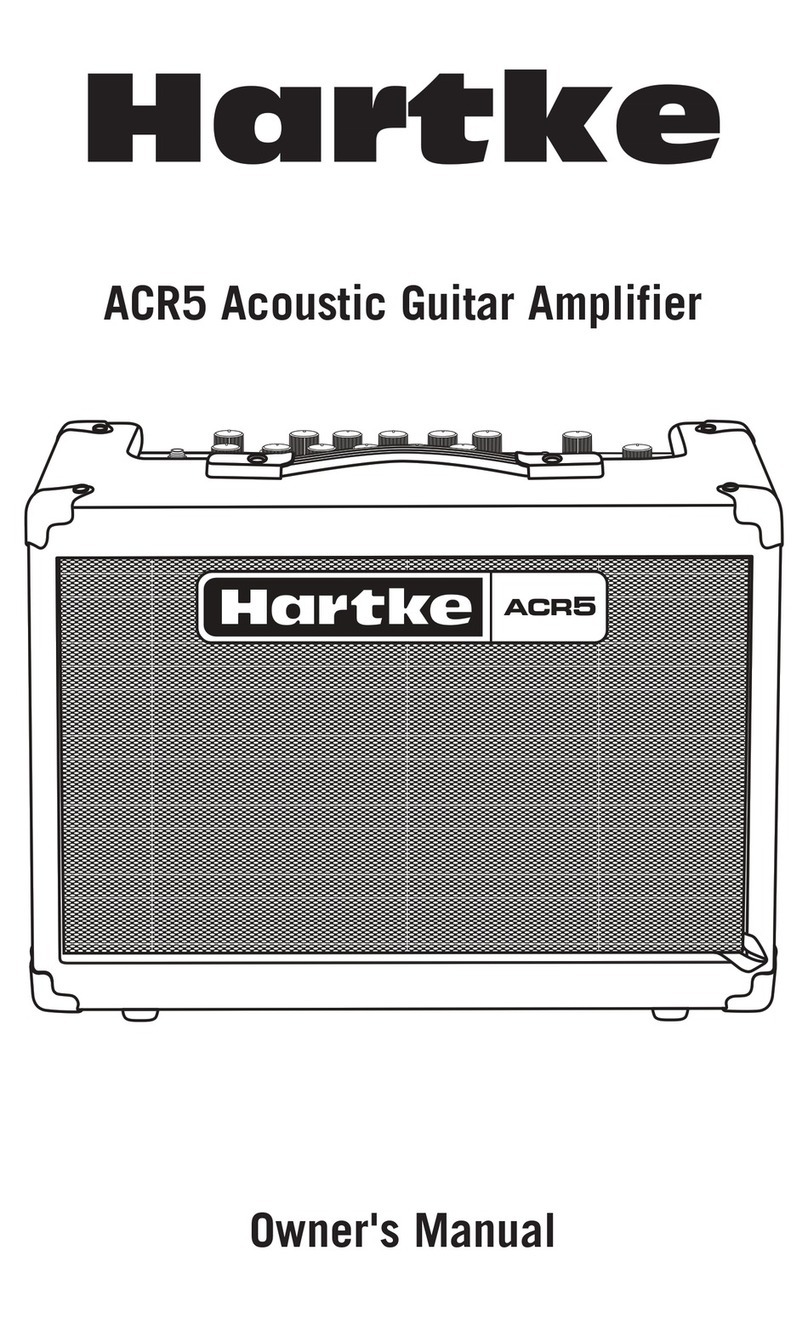
Hartke
Hartke ACR5 User manual
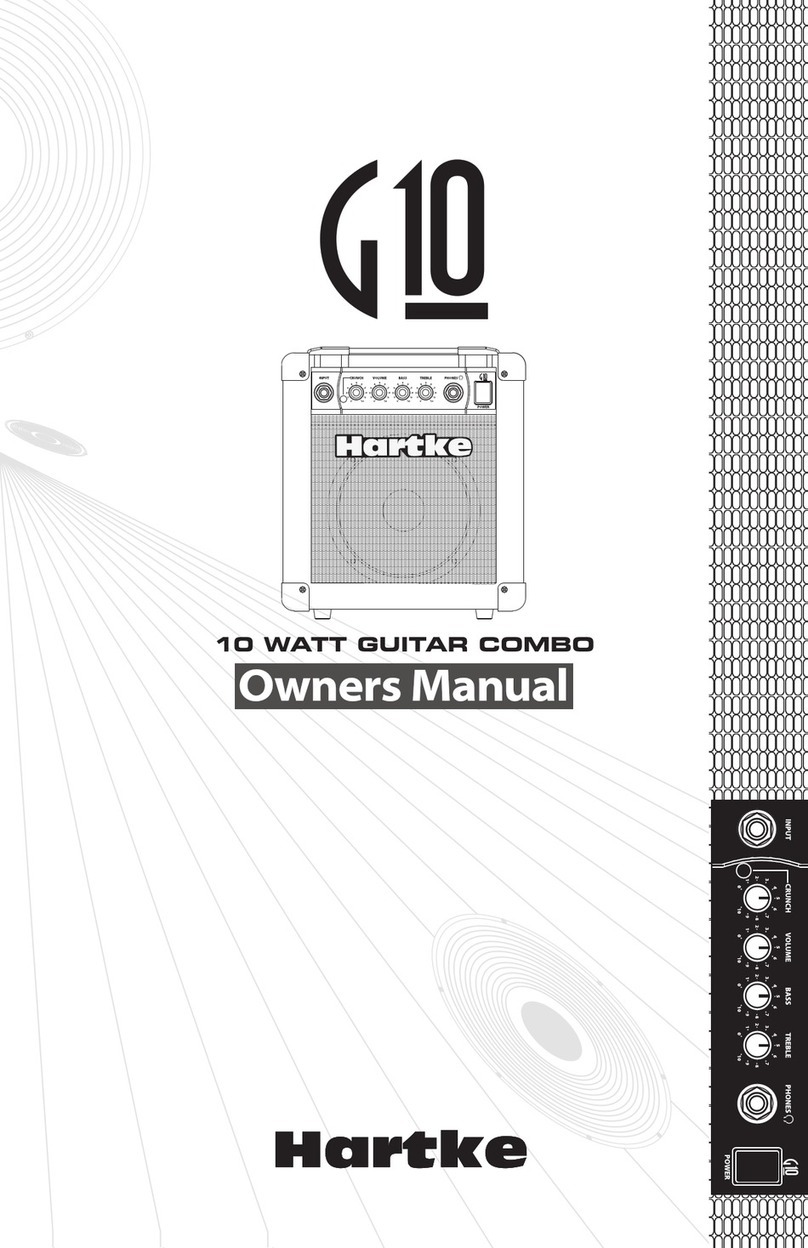
Hartke
Hartke G10 User manual
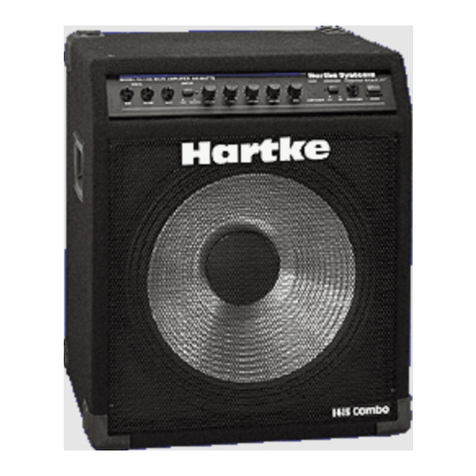
Hartke
Hartke Transient Attack 1400 User manual
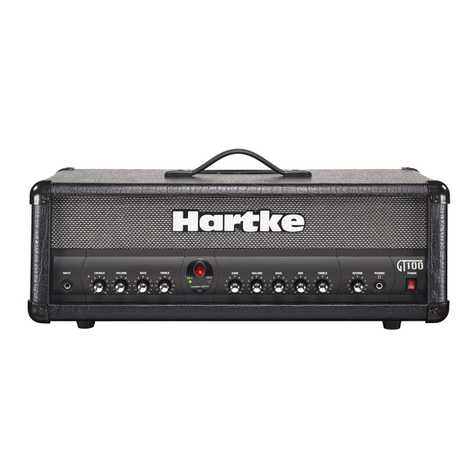
Hartke
Hartke GT100 User manual
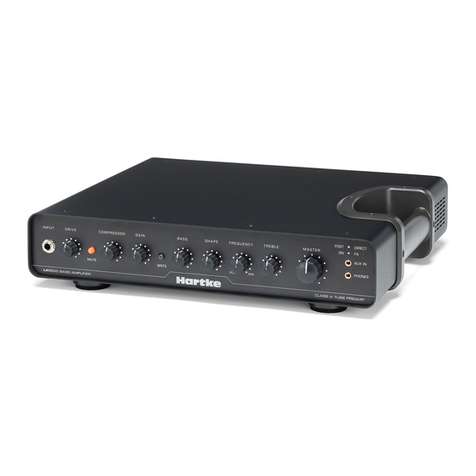
Hartke
Hartke LX8500 User manual
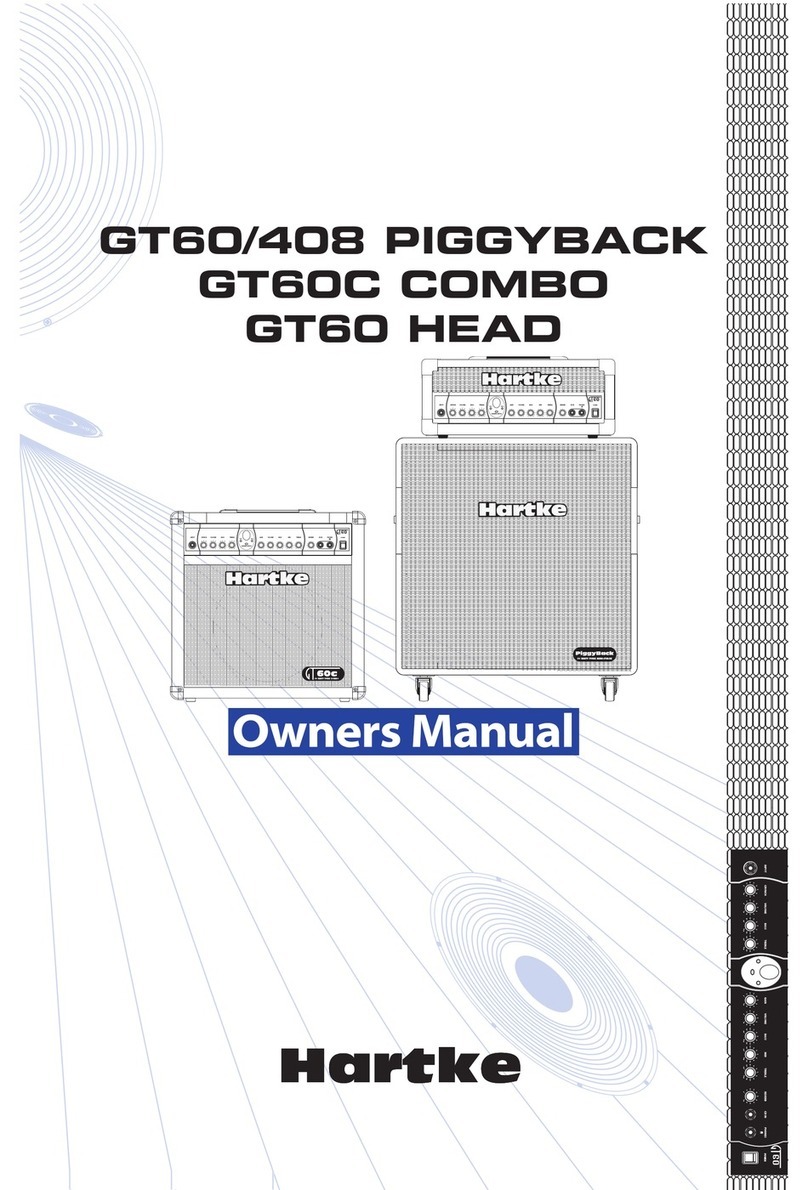
Hartke
Hartke GT60 User manual
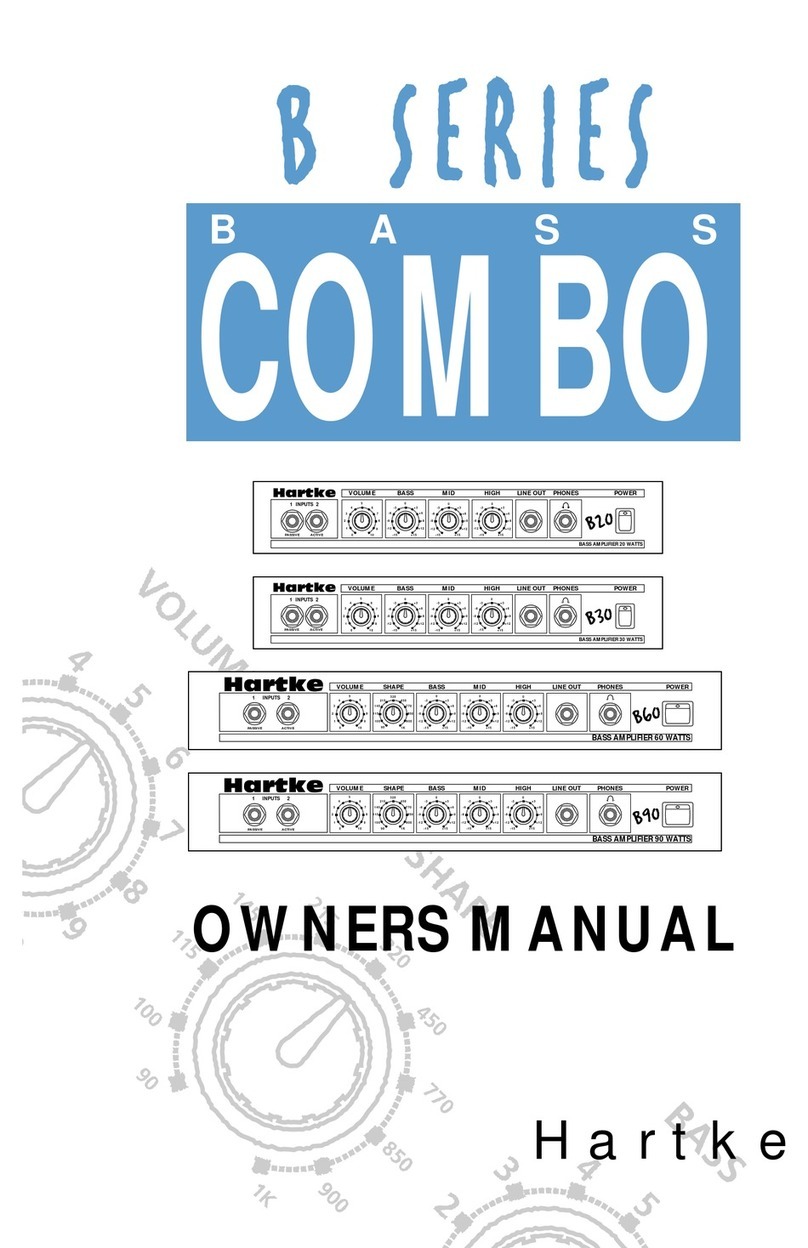
Hartke
Hartke B90 User manual
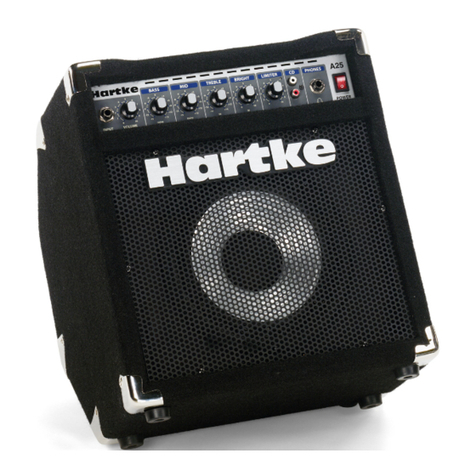
Hartke
Hartke A25 User manual

Hartke
Hartke HD15 User manual
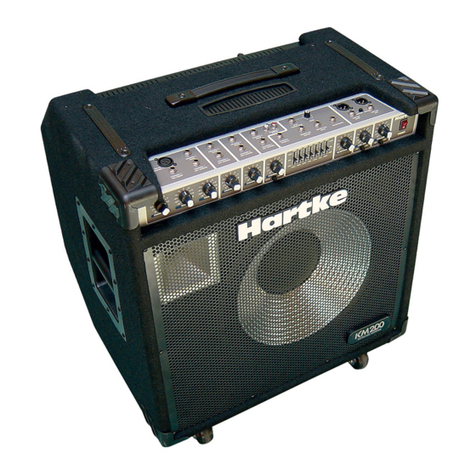
Hartke
Hartke KM200 User manual
